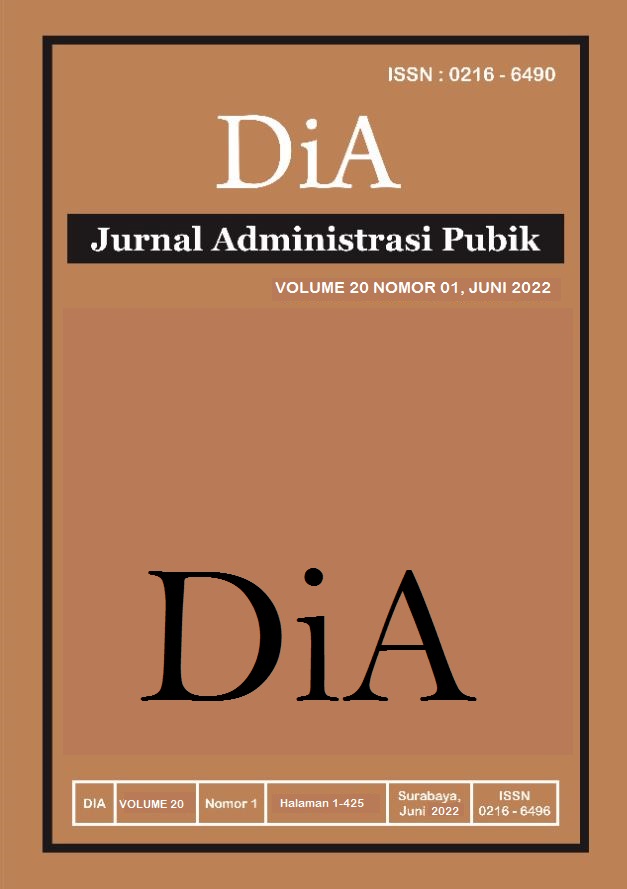“PROGRAM INDONESIA PINTAR” IMPLEMENTATION FOR UPPER SECONDARY EDUCATION IN MOJOKERTO
DOI:
https://doi.org/10.30996/dia.v20i01.5978Keywords:
Policy Implementation, Education, Program Indonesia Pintar, MojokertoAbstract
Education is one of the keys to success in effort to prepare quality resources for progress of the nation in the future. However, economic factor is one of the reasons for the high dropout rate in Indonesia. Therefore, the Government issued “Program Indonesia Pintar” Policy which aims to provide the widest opportunity for students from underpivilliged families to have access for education. The purpose of this study is to describe the inhibiting factors as well as the efforts made to overcome the problems of “Program Indonesia Pintar” implementation for the upper secondary education in Mojokerto. The results of this study indicate that the implementation of “Program Indonesia Pintar” at upper secondary level in Mojokerto encountered some obstacles seen from the policy implementation model of Van metter dan van Horn, namely the aspects of policy standards and objectives, policy sources, inter-organizational communication, characteristics of implementing agencies, socio-political economic conditios, executive dispositions. Then, the implementing agencies of “Program Indonesia Pintar” for upper secondary education in Mojokerto has sought various alternative solutions to deal with these obstacles.
Downloads
References
Bareng. 2019. Portal Resmi Pemerintah Kabupaten Jombang. [Online] Pemerintah Kabupaten
Jombang, Juni 18, 2019. [Cited: Oktober 31, 2020.]
https://jombangkab.go.id/opd/bareng/pages/peta-wilayah-kecamatan-bareng.
Erfandi, Deddy , Suryono, Jojon and Rachman, Achmad . 2007. Teknologi Pemupukan
Spesifik Lokasi dan Konservasi Tanah Desa Karangan Kecamatan Bareng Kabupaten
Jombang. Bogor : Balai Penelitian Tanah, 2007.
Knowledge Centre Perubahan Iklim. [Online] Direktorat Jenderal Pengendalian
Perubahan Iklim - Kementerian Lingkungan Hidup dan Kehutanan, 2017. [Cited:
November 1, 2020.] http://ditjenppi.menlhk.go.id/kcpi/index.php/inovasi/197-
pemanenan-air-hujan.
Mazmanian, Daniel H., dan Paul A. Sabatier. (1983). Implementation and Public Policy, New York: HarperCollins.
Matland, Richard E. (1995), Synthesizing the Implementation Literature: The AmbiguityConflict Model of Policy Implementation, Journal of Public Administration Research and Theory: J-PART, Vol.5, No.2 (Apr. 1995) 145-174 pp.
McLaughlin, Milbrey Wallin (1987), Learning From Experience: Lessons From Policy Implementation”, Educational Evaluation and Policy Analysis Vol.9, No. 2 171-178 pp.
Paudel, Raj Narendra. (2009). Critical Account of Policy Implementation Theories: Status and Reconsideration. Nepalese Journal of Public Policyand Governance, 25(2), 36-54.
Ripley, Ronald B. and Grace A. Franklin. (1986). Policy Implementation and Bereaucracy. Chicago: Dorsey Press.
Rohaeni, N Eni, and Oyon Saryono. (2018). Implementation of Program Indonesia Pintar Policy through Kartu Indonesia Pintar in Means of Education Equity. Indonesia Journal of Education Management and Administration Review 2(1). 193-204. http://dx.doi.org/10.4321/ijemar.v2i1.1824
Rusdiana, A. (2014). Education Innovation Concept (1st ed.). Bandung: PUSTAKA SETIA.
Tangkilisan, Hesel Nogi. (2003). Public Policy Implementation: The Transformation of George Edwards Thought. Yogyakarta: Lukman Offset and The Indonesia Public Administration Reform Foundation. page. 1.
Saraswati, Lilis Novia. (2017). Implementation of Program Indonesia Pintar Policy at Dasae School in Sungai Pinang Samarinda City. Journal of State Administration, 5(4), 6737-6750.
Van Meter, Donal dan Van Horn, Carl E. (1975). The Policy Implementation Process Conceptual Frame Work. Journal Administration and Society.
Yoto 2012. Analysis of Education Financing in Indonesia. Journal of Mechanical Engineering, 20(1), 78-93.
Downloads
Published
How to Cite
Issue
Section
License
The DiA journal allows authors to retain the copyright of their papers without limitation. Authors may grant publishers non-exclusive publishing rights to publish articles. Granting first publishing rights to publishers also qualifies as unlimited copyright (because there are no restrictions imposed by publishers on author copyright).






